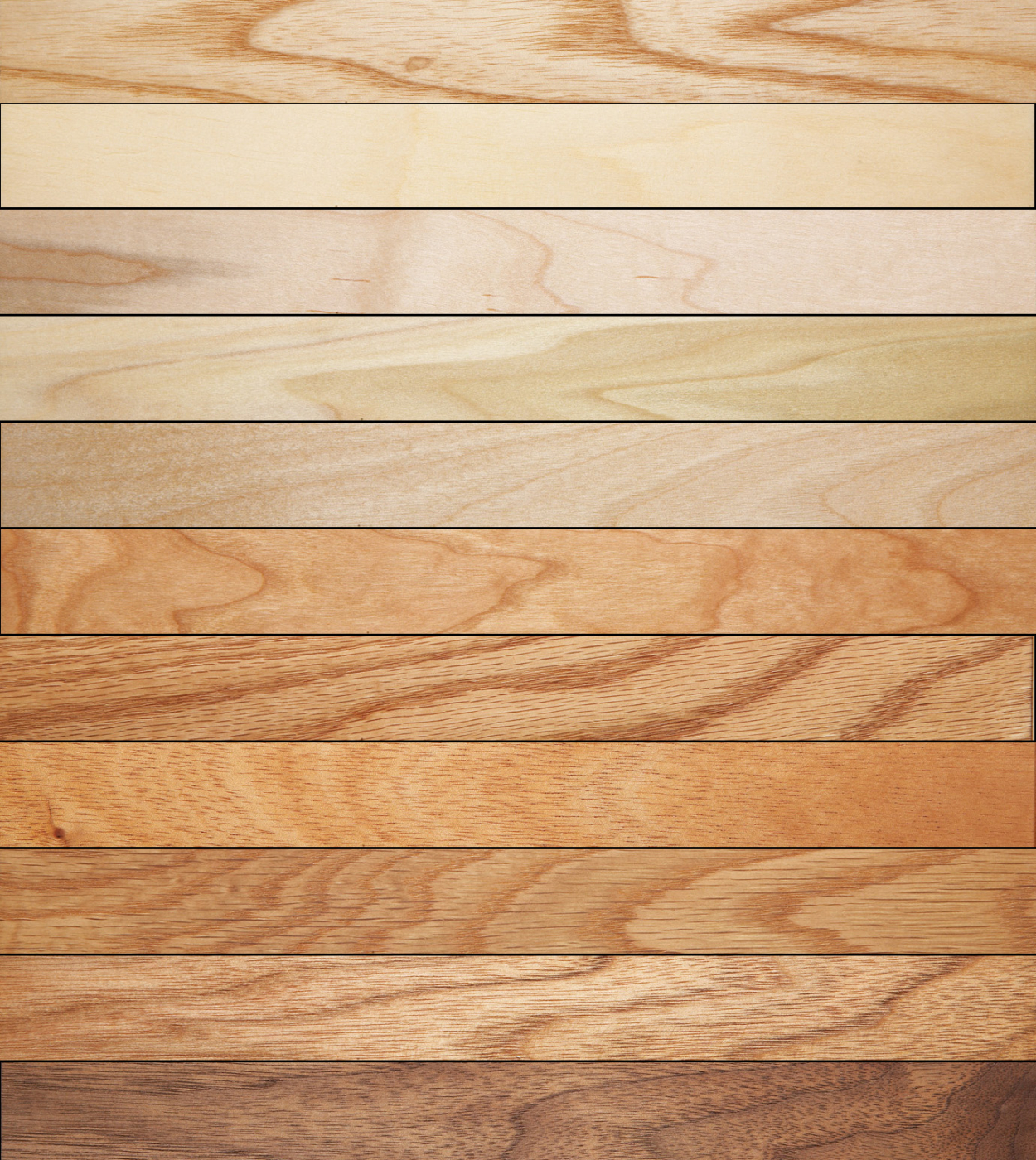We may receive a commission when you use our affiliate links. However, this does not impact our recommendations.
 Improve your results by understanding wood characteristics.
Improve your results by understanding wood characteristics.
Each species of wood has unique finishing characteristics, both positive and negative. To help you determine how to choose the right wood and get the best results when you finish your next project, I’ll explain those characteristics and sum them up in a chart that divides 11 commonly used woods into categories that affect their finished appearance. The notations in each category are based on my observations and experiences with these woods as a professional wood finisher over the past 15 years.
 Pore Structure
Pore Structure
Each species of wood is unique in appearance, thanks mainly to variations between its earlywood and latewood, but also because of the size and distribution of its pores. Pore structure is important when finishing, because most stains accentuate the pores. In ash, pores appear in the earlywood, but not in the latewood, so staining creates a strong contrast between these two elements. In walnut, the pores are evenly distributed across the earlywood and latewood, so staining creates a more uniform appearance. In maple, the pores are so small they’re virtually invisible—until stain is applied. Then they appear as dark specks that cover the surface. Also, in oak, walnut and many other species, the pores are large enough to appear as crevices when a clear finish is applied. If a glass-smooth surface is desired, these woods require extra finishing steps to fill the pores.
 Fresh Planed Color and Natural Color Change
Fresh Planed Color and Natural Color Change
All types of wood, even finished woods, change color over time, as the result of exposure to air and light. Both the color and the rate of change can vary widely. For example, cherry and maple darken relatively quickly; walnut and mahogany slowly become lighter. Knowing what color the wood will eventually become is important for finishing. It may affect whether or not you decide to use stain, for example. And if you want the Morris chair you’re building to look authentic, it’s important to know what colors to add to make that new quartersawn white oak look like it’s 100 years old.
 Sandability and Minimum Final Grit
Sandability and Minimum Final Grit
When is it time to stop sanding? The answer depends on the type of wood and the type of finish. Basically, it’s as soon as you can no longer see any sanding scratches. Dense, hard woods with smooth texture and small pores require the most effort and sanding to the highest grits. Woods with large or medium size pores allow stopping at lower grits, because the coarse texture helps to disguise the scratches. The chart indicates the minimum grit at which you can quit sanding for a clear varnish finish. Sand more carefully if you plan to stain the wood—scratches that won’t show with a clear finish are likely show up when you stain.
Many woodworkers sand to finer grits for oil finishes.
 Stainability
Stainability
Many types of wood stain well with oil-based pigment stains. The color soaks in readily and evenly and the results look good. However, some woods are difficult to stain dark, due to their density. And some woods are tricky to stain due to blotching, the random, uneven and unattractive absorption of stain. For woods that are difficult to stain dark, apply multiple coats of pigment stain or start with a dark-colored dye stain. Stain controllers or wood conditioners can be used to minimize blotching.
 The Effect of a Clear Finish
The Effect of a Clear Finish
Oil-based and water-based finishes have very different effects on a wood’s finished color. Oil-based finishes typically add a slight amber tone that benefits dark colored woods such as cherry, but can give maple and other light colored woods an unwanted yellow tone. Water-based finishes add little to no color, keeping light colored woods looking natural, but leaving dark colored woods looking pale, or even parched. Orange (amber) shellac resembles an oil-based finish. Blonde (clear) shellac and nitrocellulose lacquer add less color than oil-based finishes, but more than water based finishes.
Finishing Characteristics of Common Woods
Notes:
- The appearance of virtually any species of wood can vary widely, so exceptions to the notations will surely occur.
- The preferred choice for color (heartwood or sapwood) is listed first.
- Long-term exposure to direct sunlight causes many woods to fade.
- Sandability is the minimum final sanding grit for a clear varnish finish- you can sand to a higher grit if you prefer.
- Wood conditioner minimizes blotching and specking, but makes the wood difficult to stain dark without using a multiple-step staining process.
 Finishing Characteristics of Ash
Finishing Characteristics of Ash
Pore Structure:
Pore size: Large.
Location: Earlywood only; creates very strong grain patterns.
Glass-smooth finish: Filling required.
Fresh-Planed Color:
Sapwood: Pale tan to very light golden brown.
Heartwood: Darker.
Natural Color Change: Slightly darker and more yellow-gold.
Sandability and Minimum Final Grit: Difficult. Stop at 120 grit. Coarse grain helps to hide sanding scratches.
Stainability: Good. Challenging to make dark without using a multiple-step staining process.
Effect of Clear Finish:
Oil-based: Adds a warmer golden tone.
Water-based: Color remains light.
 Finishing Characteristics of Butternut
Finishing Characteristics of Butternut
Pore Structure:
Pore size: Medium.
Location: Throughout.
Glass-smooth finish: Filling required.
Fresh-Planed Color:
Heartwood: Light greyish, greenish, or pinkish brown.
Sapwood: White.
Natural Color Change: Lighter, to a uniform golden brown, and the pores lose their dark color.
Sandability and Minimum Final Grit: Easy to Medium. Stop at 150 grit. Coarse grain helps to hide sanding scratches. Can contain fuzzy areas
Stainability: Excellent. Stains dark easily with pigment stain or dye stain.
Effect of Clear Finish:
Oil-based: Darkens and enriches color.
Water-based: Color remains light
 Finishing Characteristics of Cherry
Finishing Characteristics of Cherry
Pore Structure:
Pore size: Small.
Location: Throughout, but more prominent in earlywood.
Glass-smooth finish: Filling not required.
Fresh-Planed Color:
Heartwood: Light pinkish to medium reddish brown.
Sapwood: White.
Natural Color Change: Darker reddish brown, although the intensity can vary greatly.
Sandability and Minimum Final Grit: Medium to Difficult. Stop at 180 grit. Higher grits are required to hide sanding scratches.
Stainability: Mediocre. Prone to blotching. Pores appear as dark specks when stained.
Effect of Clear Finish:
Oil-based: Darkens and enriches the color.
Water-based: Color becomes pale and washed out.
 Finishing Characteristics of Hard Maple
Finishing Characteristics of Hard Maple
Pore Structure:
Pore size: Very small.
Location: Throughout.
Glass-smooth finish: Filling not required.
Fresh-Planed Color:
Sapwood: Very pale tan.
Heartwood: Dark brown.
Natural Color Change: Slightly darker and more golden
Sandability and Minimum Final Grit: Difficult. Stop at 180 grit. Higher grits are required to hide sanding scratches.
Stainability: Mediocre. Prone to botching. Pores appear as dark specks when stained.
Effect of Clear Finish:
Oil-based: Adds a warmer golden tone.
Water-based: Color remains light.
 Finishing Characteristics of Mahogany
Finishing Characteristics of Mahogany
Pore Structure:
Pore size: Medium.
Location: Throughout.
Glass-smooth finish: Filling required.
Fresh-Planed Color:
Heartwood: Light to medium reddish brown.
Sapwood: Light to medium reddish brown.
Natural Color Change: Usually less reddish, lighter, more golden brown.
Sandability and Minimum Final Grit: Easy to Medium. Stop at 150 grit. The grain helps to hide sanding scratches. The density of different types of mahogany can vary widely.
Stainability: Excellent. Stains dark easily with pigment stain or dye stain.
Effect of Clear Finish:
Oil-based: Darkens and enriches the color.
Water-based: Color becomes pale and washed out.
 Finishing Characteristics of Poplar
Finishing Characteristics of Poplar
Pore Structure:
Pore size: Small.
Location: Throughout.
Glass-smooth finish: Filling not required.
Fresh-Planed Color:
Sapwood: White.
Heartwood: Green; sometimes includes dark purple or black streaks.
Natural Color Change:
Sapwood: Golden brown.
Heartwood: Dark brown.
Sandability and Minimum Final Grit: Easy. Stop 150 grit. Low density makes sanding go faster.
Stainability: Mediocre. Prone to blotching.
Effect of Clear Finish:
Oil-based: Adds a warmer golden tone to sapwood and darkens the heartwood.
Water-based: Sapwood remains light; heartwood looks washed out.
 Finishing Characteristics of Red Oak
Finishing Characteristics of Red Oak
Pore Structure:
Pore size: Very large.
Location: Earlywood only; creates very strong grain patterns.
Glass-smooth finish: Filling required.
Fresh-Planed Color:
Heartwood: Tan to slightly pinkish brown.
Sapwood: White.
Natural Color Change: Slightly darker and more golden.
Sandability and Minimum Final Grit: Medium. Stop at 120 grit. Coarse grain helps to hide sanding scratches.
Stainability: Good. Challenging to make dark without using a multiple-step staining process.
Effect of Clear Finish:
Oil-based: Adds a warmer golden tone.
Water-based: color remains light.
 Finishing Characteristics of Black Walnut
Finishing Characteristics of Black Walnut
Pore Structure:
Pore size: Medium.
Location: Throughout.
Glass-smooth finish: Filling required.
Fresh-Planed Color:
Heartwood: Dark greyish brown with purple highlights. (Describes kiln-dried walnut. Air-dried walnut heartwood is medium brown with red and gold highlights.)
Sapwood: Greyish brown to white.
Natural Color Change: Lighter and more golden brown.
Sandability and Minimum Final Grit: Medium. Stop at 150 grit. Coarse grain helps to hide sanding scratches.
Stainability: Excellent. Stains dark easily with pigment stain or dye stain.
Effect of Clear Finish:
Oil-based: Darkens and enriches the color.
Water-based: Color becomes pale and washed out.
 Finishing Characteristics of White Birch
Finishing Characteristics of White Birch
Pore Structure:
Pore size: Small.
Location: Throughout.
Glass-smooth finish: Filling not required.
Fresh-Planed Color:
Sapwood: Pale, slightly golden brown.
Heartwood: Dark brown.
Natural Color Change: Slightly darker and more golden.
Sandability and Minimum Final Grit: Medium. Stop at 150 grit.
Stainability: Mediocre. Prone to blotching. Pores appear as dark specks when stained.
Effect of Clear Finish:
Oil-based: Adds a warmer golden tone.
Water-based: Color remains light.
 Finishing Characteristics of White Oak
Finishing Characteristics of White Oak
Pore Structure:
Pore size: Large.
Location: Earlywood only; creates very strong grain patterns.
Glass-smooth finish: Filling required.
Fresh-Planed Color:
Sapwood: Tan to very light greyish brown.
Heartwood: Darker.
Natural Color Change: Slightly darker and more golden.
Sandability and Minimum Final Grit: Very Difficult. Stop at 120 grit. Coarse grain helps to hide sanding scratches.
Stainability: Good. Challenging to make dark without using a multiple-step staining process.
Effect of Clear Finish:
Oil-based: Adds a warmer golden tone.
Water-based: Color becomes pale and washed-out.
 Finishing Characteristics of White Pine
Finishing Characteristics of White Pine
Pore Structure: None–coniferous.
Glass-smooth finish: Filling not required.
Fresh-Planed Color:
Heartwood: Pale tan.
Sapwood: Pale tan.
Natural Color Change: Slightly darker and more golden brown.
Sandability and Minimum Final Grit: Easy. Stop at 150 grit. Low density makes sanding go faster.
Stainability: Mediocre. Prone to blotching. Earlywood is much more absorbent to stain and finish than latewood.
Effect of Clear Finish:
Oil-based: Adds a warmer golden tone.
Water-based: Color remains light.
Download a PDF chart of wood finishing characteristics
Here are some supplies and tools we find essential in our everyday work around the shop. We may receive a commission from sales referred by our links; however, we have carefully selected these products for their usefulness and quality.



 Improve your results by understanding wood characteristics.
Improve your results by understanding wood characteristics. Finishing Characteristics of Ash
Finishing Characteristics of Ash Finishing Characteristics of Butternut
Finishing Characteristics of Butternut Finishing Characteristics of Cherry
Finishing Characteristics of Cherry Finishing Characteristics of Hard Maple
Finishing Characteristics of Hard Maple Finishing Characteristics of Mahogany
Finishing Characteristics of Mahogany Finishing Characteristics of
Finishing Characteristics of  Finishing Characteristics of
Finishing Characteristics of  Finishing Characteristics of
Finishing Characteristics of  Finishing Characteristics of
Finishing Characteristics of  Finishing Characteristics of
Finishing Characteristics of  Finishing Characteristics of
Finishing Characteristics of 




